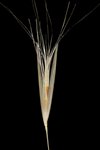
T. schinzii spikelet.
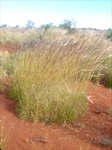
T. schinzii habitat.
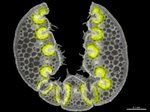
T. schinzii leaf section.
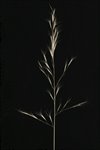
T. schinzii inflorescence.

T. schinzii glumes.

T. schinzii lemmas.
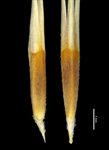
T. schinzii lemma bases.
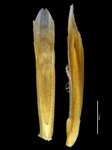
T. schinzii paleas.

T. schinzii map.

Comparison of T. avenoides (right) and T. schinzii (left) glume bases, showing difference in width.

T. avenoides (right) and T. schinzii (left) lemma base comparison, showing difference in lemma width.
Name
Triodia schinzii (Henrard) Lazarides
Citation
Austral. Syst. Bot. 10: 474 (1997)
Derivation
schinzii — in honour of Hans Schinz (1858–1941), Swiss explorer and botanist.Common name
Feathertop Spinifex
Synonyms
Plectrachne schinzii Henrard
Plectrachne helmsii (C.E. Hubb.) Lazarides
Diagnostic features
Foliage resinous; leaf sheath surfaces glabrous; leaf blades epistomatous (soft-type); lower glume narrowly lanceolate, (12.7–)15.5–26 mm long, 0.8–1.25 mm wide, 7–11-nerved; lemmas lobed and awned, strongly bitextured with hairs all over the surface in the lower part; palea bitextured, lacking hairs; on sand or dunes in the eastern half of the Pilbara, and deserts to east of Pilbara.
Habitat
Occurs on sand or sandy loam, often on dunes and deeper sand pockets
Distribution and frequency
Widespread throughout central Australia. Forms extensive populations on large sand sheets in the Great Sandy and Little Sandy deserts, also on subcoastal sands between Karratha and Pardoo (in the eastern Roebourne sub-region and southern Dampierland). Also occurs in scattered pockets throughout the eastern half of the Chichester and Fortescue sub-regions. Does not occur in the west Pilbara, where it is replaced by T. avenoides.
Similar species
Triodia schinzii belongs to the Soft group, sharing the epistomatous (soft-type) leaf blades and foliage resin.
Most similar to T. avenoides, sharing the narrowly lanceolate glumes, 3-awned and bitextured lemmas, and sharply acute callus ≥0.8 mm long. Triodia avenoides differs from T. schinzii in having lemma body 1.3–1.8 mm wide (0.8–1.25 mm wide in T. schinzii), broader glumes (2.1–)2.2–3.6 mm wide [1.5–2.1(–2.2) mm wide in T. schinzii], 2–3 spikelets on the longest (basal) panicle branches (3–5 spikelets in T. schinzii), and a non-overlapping distribution. Triodia avenoides occurs on sands of the Carnarvon Basin west of the Pilbara, while T. schinzii occurs to north and east, on sands of the Dampierland, Great Sandy Desert and Little Sandy Desert, extending into the Pilbara on sand plains between Port Hedland and Karratha, in patches in the eastern Chichester west to Abydos and Woodstock stations, and along the Fortescue Valley east of Munjina (Auski).
Several species sharing awned lemmas and bitextured lemma body occur in the Pilbara. Other than T. avenoides discussed above, all occur on rocky substrates. Triodia basitricha differs in having smaller glumes, and hairs on the surface of the leaf sheaths (glabrous in T. schinzii).
Triodia sp. Mt Ella differs in having a hairy palea, shorter glumes ≤12.5 mm long and a shorter callus ≤0.7 mm long (palea glabrous, glumes ≥15 mm, callus long-pungent and ≥0.8 in T. schinzii).
Triodia degreyensis differs in having a hairy palea, generally shorter glumes 12.4–17 mm long and a shorter callus <0.5 mm long (palea glabrous, glumes (12.7–)15.5–26 mm long, callus long-pungent and ≥0.8 in T. schinzii), as well as occurring on a rocky substrate and a disjunct distribution.
Conservation status
Not considered at risk.
Identification without florets
Several other species share resinous foliage, narrowly lanceolate glumes and a distribution from the central Pilbara south or east (T. degreyensis, T. melvillei, T. veniciae, and T. sp. Mt Ella). Triodia veniciae and T. sp. Mt Ella occur on rocky substrates, and T. melvillei usually on loam or gravelly loam (T. schinzii always on sand or sandy loam). Triodia melvillei, T. veniciae, and T. sp. Mt Ella have 3–5-nerved glumes (or occasionally very faint nerves), while T. schinzii has 7–11-nerved glumes (with at least 7 nerves clearly visible).
Variation
A relatively uniform species
Notes
The concept of T. schinzii in Lazarides (1997), Lazarides et al. (2005) and Ausgrass (Sharp & Simon, 2002; Simon & Alonso, 2014) included T. avenoides and T. basitricha which have since been described as distinct species (Barrett 2017, Barrett & Barrett 2015 respectively).
A full description of T. schinzii can be found in Barrett (2017b).
Sometimes killed completely by fire, at other times resprouting (Rice & Westoby 1999).